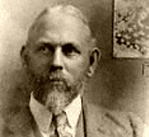 |
| Hannah Riddell |
Hannah Riddell was a British woman who saved many Japanese patients. But her job was not a doctor. When she came to Japan, she was shocked by Japanese situation for a certain group of people.
She was born in 1855 in North London. She managed small private school with her mother. However, after her parents passed away, she went bankrupt. She joined Church Missionary Society to make her life again. So she came to Japan as a missionary in 1891. She stayed in Kumamoto with her co-workers. As well as her missionary work, she studied Japanese and taught English at local high school in Kumamoto.
In the same year she came to Japan, Riddell saw some people who were suffering from something in Honmyo temple. And they begged passers-by for alms. They were all Hansen’s disease (leprosy) patients. At that time, the patients of this disease were discriminated against and isolated because of their appearance (symptoms) such as a rash and 2 misunderstandings.
Hansen’s disease is curable now, however, it was considered to be incurable disease. And many people believed it was contagious disease. In fact, the possibility of infection is quite low. These misunderstandings also caused suffering for the patients.
In Europe, there had been patients of Hansen’s disease, and discrimination against them, in the Middle Ages. But in modern time, this situation had improved greatly. So Riddell was shocked by this difference of situation between Japan and Europe.
Riddell decided to help them. At first, she wrote a letter about what she saw and her desire to build hospital for the patients to YMCA, which organization she joined as headmistress. She also asked support to Church Missionary Society. But both of them replied “No”, because they thought it was impossible for a foreign woman to build hospital in Japan. Nonetheless, she never gave up. She also asked support to her friends in Liverpool. Her characteristics helped a lot: she was very active to make new relationship and contact with someone who has authority. She made relationships in Kumamoto. She sometimes held tea parties with professors of school and prefectural officers. She talked about strong wish to save the patients.
By her these efforts, Hannah could get agreement for her idea and support from some people of CMS. In 1985, she finally built Kaisyun (回春) hospital for the patients of Hansen’s disease. Kaisyun means “resurrection of hope” in English. She named from her thought and wish that although patients had felt much pain for a long time, now they could get back hope again.
Riddell and Kaisyun hospital still had the problem for managing and money. So she decided to write a letter to Okuma Shigenobu who was prime minister of Japan at that time. She explained about treatment of patient and how situation was bad. Next year, the meeting about relief for Hansen’s disease patient was held. It was the first time this problem was discussed as a national problem. From this time, Japanese support system has developed quickly.
Riddell came to Japan as a missionary, however, she saved the patients of Hansen’s disease not as a missionary. She saved them just as a foreign woman. So, we discussed about “if you find someone who was discriminated against or suffered from some kind of reason or disease when you were in foreign country, what would you do?” in my group. Our main opinion was we couldn't do anything for them because we wouldn’t know anything about their situation and rules in the country. And we are just a foreigner. It is difficult problem even now. Especially, in 1890s the visit to Japan of foreigners was more limited than now. So the position of foreign women was not so stable and they didn't have social power at that time. But Riddell was so brave and active person doing something new. These attitudes for Japanese serious situation changed one aspect of Japanese society and medical situation. However I don’t think every foreigner and even local people could behave like her. All we could do and need to do is to know about the country and situation well. It is true that we couldn't do anything if we don’t know anything about it. So I think we can begin help with knowing the situation.
References
Retrieved June 18 2014. Wikipedia
http://ja.wikipedia.org/wiki/%E3%83%8F%E3%83%B3%E3%83%8A%E3%83%BB%E3%83%AA%E3%83%87%E3%83%AB
Retrieved June 25 2014. Fukushi shinbun web
http://www.fukushishimbun.co.jp/topics/3416
http://www.fukushishimbun.co.jp/topics/3488
http://www.fukushishimbun.co.jp/topics/3529
http://www.fukushishimbun.co.jp/series02/3571
http://www.fukushishimbun.co.jp/topics/3682
http://www.fukushishimbun.co.jp/topics/3819
Picture
from http://riddell-wright.com/history_index.php

